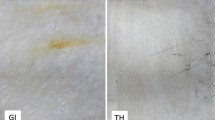Abstract
Studies of marble panels from the exterior of two buildings document the processes leading to bowing of the material. Bowing of panels is most extensive in those areas that are exposed to direct or reflected thermal energy. The thermal anisotropic behavior of calcite results in grain-boundary separation, grain sliding and microfracturing. The resulting loss of strength is one factor leading to bowing. The development of bows further reduces the panel strength as the outer portions elongate by inelastic deformation mechanisms. Laboratory experiments cycling marble samples for over 200 cycles at three temperatures up to 107°C above room conditions show similar strength losses as the natural situation. The second factor contributing to the bowing process is the release of residual elastic strain. The strain is in part stored in the marble from its geologic history, but may also be accumulated during thermal cycling due to the properties of calcite. Marble panels have been found to bow when stored outside, but not attached to any framework, indicating that the release of residual strain is a critical factor in producing the bows.














Similar content being viewed by others
References
Bortz S, Stecich J, Wonneberger B, Chin I (1993) Accelerated weathering in building stone. Int J Rock Mech Min Sci Geomech Abstr 30:1559–1566
Clark SP Jr (1966) Handbook of Physical Constants. Geol Soc Am, New York, 587 pp
Collins JA (1981) Failure of Materials in Mechanical Design. Wiley, New York
Dal Pino R, Narducci P, Royer-Carfagni G (1999) A SEM investigation on fatigue damage of marble. J Mat Sci Lett 18:1619–1622
Dunakin R (1999) Mechanical aspects of weathering in marble crack growth. Master of Science Thesis, Department of Material Science and Engineering, Royal Institute of Technology, Stockholm, Sweden
ERTAG (1980) I Marmi Apuani, Nuova Grafica Fiorentina, Firenze
Forlani G, Iori I, Necchi G, Royer-Carfagni G (2000) Proposta per una caratterizzazione microstrutturale dei conglomerati naturali. Studi e Ricerche - Studies and Researches 21:125–155
International Society of Rock Mechanics (1985) Suggested method for determining point-load strength. Int J Rock Mech Min Sci Geomech Abstr 22:3–60
Jaeger JC, Cook NGW (1969) Fundamentals of Rock Mechanics. Methuen, London
Logan JM, Hastedt M, Lehnert D, Denton M (1993) A case study of the properties of marble as building veneer. Int J Rock Mech Min Sci Geomech Abstr 30:1531–1537
McGee ES (1999) Colorado Yule Marble–Building stone of the Lincoln Memorial, U.S. Geological Survey Bull 2162
Rayleigh Lord (1934) The bending of marble. Proc R Soc A 144:266–279
Ritter H (1992) Die Marmorplatten sind falsch dimensioniert. Stein 1:18–19
Royer-Carfagni G (2000) Some considerations on the warping of marble facades. The example of Alvar Aalto’s Finland Hall in Helsinki. Construction and Building Materials 13:449–457
Siegesmund S, Ullemeyer K, Weiss T, Tschegg EK (2000) Physical weathering of marbles caused by anisotropic thermal expansion. Int J Earth Sci 89:170–182
Simmons G, Richter D (1993), Cracks in building stone. Int J Rock Mech Min Sci Geomech Abstr 30:1553–1557
Winkler EM (1987) Weathering and weathering rates of natural stone. Environ Geol Water Sci 9:85–92
Zeisig A, Siegesmund S, Weiss T (2000) Thermal expansion and its control on the durability of marbles. Geol Soc London, Spec Pub 205:57–72
Acknowledgements
Support for the study of the Amoco Building was provided by Amoco Corporation, which then had headquarters in Chicago. M. Hastedt, D. Lehnert and M. Denton contributed to both the data acquisition and analysis. The work in Toronto, Canada was generously supported by O&Y Enterprise, Toronto and benefited from reviews of this work by M. Wertheim and F. Hauer of that company. J. Shelemay of O&Y provided extensive logistical support. Constructive reviews by T. Weiss and G. Royer-Carfagni significantly improved this paper. The invitation by S. Siegesmund to publish this work is appreciated.
Author information
Authors and Affiliations
Corresponding author
Rights and permissions
About this article
Cite this article
Logan, J.M. Laboratory and case studies of thermal cycling and stored strain on the stability of selected marbles. Env Geol 46, 456–467 (2004). https://doi.org/10.1007/s00254-004-1047-7
Received:
Accepted:
Published:
Issue Date:
DOI: https://doi.org/10.1007/s00254-004-1047-7




